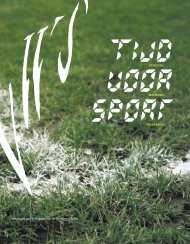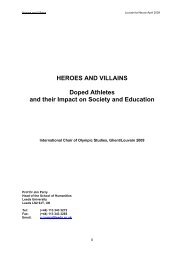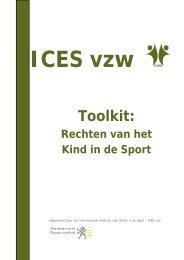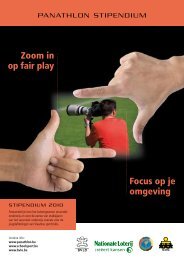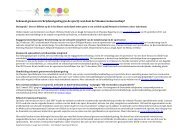Part 3 GLOBAL ISSUES: HARASSMENT AND ABUSE RESEARCH
Part 3 GLOBAL ISSUES: HARASSMENT AND ABUSE RESEARCH
Part 3 GLOBAL ISSUES: HARASSMENT AND ABUSE RESEARCH
You also want an ePaper? Increase the reach of your titles
YUMPU automatically turns print PDFs into web optimized ePapers that Google loves.
automatically mean that he/she will become an abuser. The abuser has to set<br />
aside his/her inner inhibitions (phase 2). For the abuser, feelings of inferiority<br />
and disruptive sexual relationships play a part in both stages, as can<br />
sociocultural indicators such as a lack of punitive measures within the sport.<br />
Risk factors: the sport situation<br />
By supervising and protecting the athlete the environment creates<br />
external inhibitions for the abuser that have to be overcome (phase 3). The<br />
erosion of social networks and lack of social support from the environment are<br />
clear risk indicators, as is the internal culture of the sport.<br />
Risk factors: the athlete<br />
The last step of the sequential process is overcoming the resistance of<br />
the child. The abuser will try to undermine the defensibility of the athlete.<br />
Indicators are actions or events which cause the child to feel insecure,<br />
helpless or abandoned. A weak social position and low self-esteem are<br />
examples of indicators that increase the risk of abuse. A clear indicator is a<br />
relationship of extreme dependence on a coach who, to a certain extent,<br />
controls the life of the athlete.<br />
Continuation and end of the abuse<br />
The interviews gave additional information about the strategies of the<br />
abusers and the process of the abuse at the point where the actual abuse<br />
takes place and the phase following the end of the abuse. Sexual abuse may<br />
continue for several years: for seven of the interviewees it went on for<br />
between two and five years, without the athlete telling anybody about it or<br />
ending it in another way. Not recognising abuse in the early stages, shame<br />
and fear of the consequences are all important reasons why athletes keep<br />
silent. In all cases the athletes had ended the abuse themselves, because the<br />
power of the coach over them decreased, or because they became less<br />
involved in the sport, left home or became involved in a different intimate<br />
relationship.<br />
Development of policy and policy instruments<br />
33




